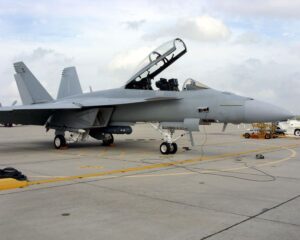The Navy recently conducted the first successful test flights of the Northrop Grumman [NOC] AN/AAQ-28(V) LITENING targeting pods on the
Boeing [BA] F/A-18E/F Super Hornet, the company said on Wednesday.
In these tests, Super Hornet pilots performed maneuvers and operations meant to be representative of combat missions, like ground moving target tracking, air-to-air tracking and target designation.

The pilots also engaged the pod’s “eye-safe training laser mode,” which allows the pod to be used in realistic training with combat controllers on the ground.
James Conroy, Northrop Grumman vice president for navigation, targeting and survivability, told Defense Daily that while initial tests took place in 2021, follow-on testing occurred this July and August.
Northrop Grumman boasted the pilots were able to carry out these activities without advance training showing the ease of use that has been made possible by close collaboration with the aviation community.
“This first flight demonstrated LITENING’s ability to rapidly add modern, upgradeable mission capabilities to the Super Hornet,” Conroy said in a statement.
“The pod’s digital video, autonomous target tracking, and laser sensors will give Naval aviators an entirely new set of capabilities for operations over land and sea today, and the growth capabilities built into LITENING’s modular design ensure that the pod can evolve to meet changing requirements,” he added.
The LITENING pod is a self-contained electro-optical infrared sensor system that gives pilots the capability to detect, acquire, auto-track and identify targets at long ranges to accurately deliver conventional and precision-guided weapons. The pods include high definition video, 1K forward-looking infrared and charge-coupled device sensors, simultaneous view from up to three sensors, plug-and-play data links, and short wave infrared laser imaging.
Conroy told Defense Daily the company is continuing to fly the pod and work on integration in preparation for aircraft carrier qualifications.
“We are actively working toward catapult-assisted take-off and arrested landing testing.”
In its original request for information, the Navy said the pods should be available to start service in 2023. Conroy said right now the specific rate of installation on Navy aircraft “has yet to be determined.”
Northrop Grumman noted it has delivered over 900 LITENING pods currently being used by the Marine Corps, Air Force, Air National Guard and international customers.
In 2015, Northrop Grumman said the LITENING targeting pods achieved two mission operating hours (Defense Daily, Feb. 24, 2015).
Since then, the company’s webpage on the product says the pods have over three million operational hours and over one million hours in combat. It also said over upward of 20 years the pods have LITENING team has maintained an availability rate over 95 percent.